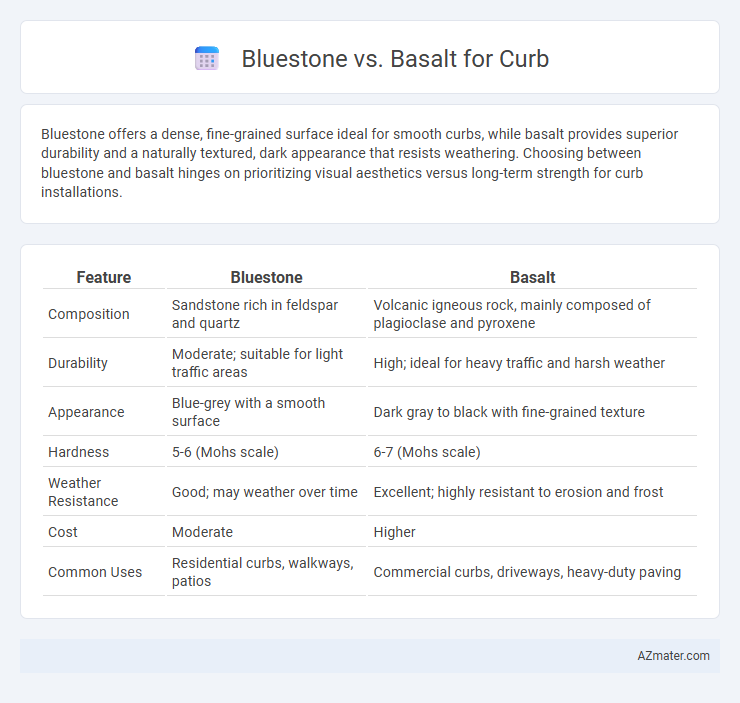Bluestone offers a dense, fine-grained surface ideal for smooth curbs, while basalt provides superior durability and a naturally textured, dark appearance that resists weathering. Choosing between bluestone and basalt hinges on prioritizing visual aesthetics versus long-term strength for curb installations.
Table of Comparison
| Feature | Bluestone | Basalt |
|---|---|---|
| Composition | Sandstone rich in feldspar and quartz | Volcanic igneous rock, mainly composed of plagioclase and pyroxene |
| Durability | Moderate; suitable for light traffic areas | High; ideal for heavy traffic and harsh weather |
| Appearance | Blue-grey with a smooth surface | Dark gray to black with fine-grained texture |
| Hardness | 5-6 (Mohs scale) | 6-7 (Mohs scale) |
| Weather Resistance | Good; may weather over time | Excellent; highly resistant to erosion and frost |
| Cost | Moderate | Higher |
| Common Uses | Residential curbs, walkways, patios | Commercial curbs, driveways, heavy-duty paving |
Introduction to Bluestone and Basalt Curbs
Bluestone curbs are crafted from dense, durable sandstone known for its rich blue-gray hues and natural cleft surface, providing a timeless aesthetic for urban and residential landscapes. Basalt curbs, made from igneous volcanic rock, offer exceptional hardness and a dark, consistent color ideal for high-traffic areas requiring long-lasting resilience. Both materials ensure superior curb performance but differ in appearance, texture, and geological origin, influencing design choices and maintenance needs.
Geological Origins: Bluestone vs Basalt
Bluestone originates from sandstone, primarily composed of quartz and feldspar, formed through sedimentary processes over millions of years. Basalt is an igneous rock created from rapidly cooled lava, rich in iron and magnesium minerals, giving it a dense and durable structure. These distinct geological origins influence their texture, durability, and suitability for curb applications, with bluestone offering a more layered appearance and basalt providing superior strength and weather resistance.
Physical Appearance and Color Variations
Bluestone features a smooth texture with blue-gray tones often interspersed with subtle greens and pinks, offering a sleek and uniform appearance for curbing. Basalt displays a finer grain structure with predominantly dark gray to black shades, sometimes exhibiting slight metallic sheens that create a more dramatic and bold curb look. Both materials provide durability but differ significantly in visual impact due to their distinctive color variations and surface textures.
Strength and Durability Comparison
Bluestone and basalt both offer exceptional strength and durability for curb applications, with basalt typically exhibiting higher compressive strength and superior resistance to weathering due to its volcanic origin. Bluestone, a dense sandstone, provides excellent durability and a smooth finish but may be more susceptible to chipping under heavy impact compared to basalt. Basalt's fine-grained texture and hardness make it ideal for high-traffic environments requiring long-lasting curb materials resistant to abrasion and freeze-thaw cycles.
Slip Resistance and Safety Features
Bluestone offers excellent slip resistance due to its natural cleft surface finish, making it a safe option for curbs in wet or icy conditions. Basalt provides superior hardness and durability but often requires textured finishing to enhance its slip-resistant properties. Both stones are ideal for curbs; however, Bluestone's naturally rough texture typically ensures better traction and reduces the risk of slips and falls.
Weather Resistance and Longevity
Bluestone exhibits excellent weather resistance due to its dense composition, making it highly durable against freeze-thaw cycles and moisture exposure. Basalt's inherent hardness and low porosity contribute to superior longevity, withstanding extreme weather conditions and minimizing erosion over time. Both materials offer robust curb solutions, but basalt's higher resistance to wear ensures extended lifespan in harsh environments.
Installation Process and Ease of Use
Bluestone offers a smoother surface that simplifies cutting and shaping during installation, making it ideal for precise curb layouts. Basalt's dense composition requires specialized tools and more labor-intensive techniques, which can increase installation time and complexity. Bluestone's lighter weight also contributes to easier handling on-site, whereas basalt demands more effort to maneuver and position accurately.
Cost Analysis: Bluestone vs Basalt
Bluestone and basalt present distinct cost considerations for curb installations, with bluestone typically priced higher due to its natural aesthetic and limited regional availability. Basalt offers a more economical alternative, benefiting from greater abundance and lower extraction expenses, making it preferable for large-scale projects. Installation costs for both materials are comparable, but overall expenses hinge on stone grade, size, and local market demand.
Maintenance Requirements
Bluestone curbs require regular sealing to prevent staining and weathering, with occasional power washing recommended to maintain their appearance. Basalt curbs are more durable and resistant to abrasion, requiring less frequent maintenance but benefiting from periodic cleaning to remove dirt and debris. Both materials withstand freeze-thaw cycles well, but basalt's dense structure reduces the risk of surface deterioration over time compared to bluestone.
Environmental Impact and Sustainability
Bluestone and basalt both offer sustainable options for curbs, with basalt generally exhibiting higher durability and a lower environmental impact due to its abundance and minimal quarrying footprint. Bluestone, while attractive and locally sourced in certain regions, may require more energy-intensive extraction and processing, affecting its overall carbon footprint. Choosing basalt can contribute to longer-lasting infrastructure and reduced maintenance needs, aligning better with eco-friendly construction practices.

Infographic: Bluestone vs Basalt for Curb
 azmater.com
azmater.com